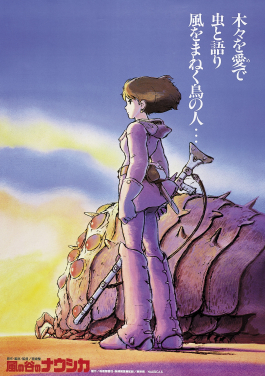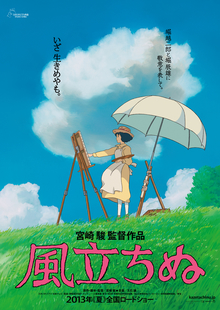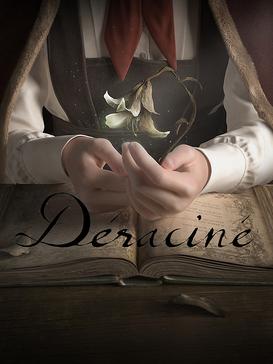
Hayao Miyazaki is a Japanese animator, filmmaker, and manga artist. A founder of Studio Ghibli, he has attained international acclaim as a masterful storyteller and creator of Japanese animated feature films, and is widely regarded as one of the most accomplished filmmakers in the history of animation.

Princess Mononoke is a 1997 Japanese animated epic historical fantasy film written and directed by Hayao Miyazaki and animated by Studio Ghibli for Tokuma Shoten, Nippon Television Network and Dentsu. The film stars the voices of Yōji Matsuda, Yuriko Ishida, Yūko Tanaka, Kaoru Kobayashi, Masahiko Nishimura, Tsunehiko Kamijo, Akihiro Miwa, Mitsuko Mori, and Hisaya Morishige.

Nausicaä of the Valley of the Wind is a 1984 Japanese animated post-apocalyptic fantasy film written and directed by Hayao Miyazaki, based on his 1982–94 manga series of the same name. It was produced by Topcraft and distributed by Toei Company. Joe Hisaishi, in his first collaboration with Miyazaki, composed the score. The film stars the voices of Sumi Shimamoto, Gorō Naya, Yōji Matsuda, Yoshiko Sakakibara and Iemasa Kayumi. Set in a post-nuclear futuristic world, it tells the story of Nausicaä (Shimamoto), the teenage princess of the Valley of the Wind who becomes embroiled in a struggle with Tolmekia, a kingdom that tries to use an ancient weapon to eradicate a jungle full of giant mutant insects.

Castle in the Sky, also known as Laputa: Castle in the Sky, is a 1986 Japanese animated fantasy adventure film written and directed by Hayao Miyazaki. It was produced by Isao Takahata, animated by Studio Ghibli, and distributed by the Toei Company. In voice acting roles, the original Japanese version stars Mayumi Tanaka, Keiko Yokozawa, Kotoe Hatsui, and Minori Terada. The film follows orphans Sheeta and Pazu, who are pursued by government agent Muska, the army, and a group of pirates. They seek Sheeta's crystal necklace, the key to accessing Laputa, a legendary flying castle hosting advanced technology.

Kiki's Delivery Service is a 1989 Japanese animated fantasy film written, produced, and directed by Hayao Miyazaki, based on the 1985 novel of the same name by Eiko Kadono. It was animated by Studio Ghibli for Tokuma Shoten, Yamato Transport and the Nippon Television Network, and stars the voices of Minami Takayama, Rei Sakuma and Kappei Yamaguchi. The story follows Kiki, a young witch who moves to the port city of Koriko with her cat Jiji and starts a flying courier service.

The Sea Shall Not Have Them is a 1954 British war film starring Michael Redgrave, Dirk Bogarde and Anthony Steel. It was directed by Lewis Gilbert and is based on the 1953 novel by John Harris, about a North Sea rescue during the Second World War. The musical soundtrack is by composer Malcolm Arnold.

Campbell College located in Belfast, Northern Ireland and founded in 1894 comprises a preparatory school department and a senior Northern Ireland 'Voluntary Grammar' school, the latter meaning, in terms of provision of education, a government funded, selective school.

The Skinners' School, is a British Grammar School with academy status for boys located in the town of Royal Tunbridge Wells, Kent, England. Established in 1887, the school was founded by the Worshipful Company of Skinners in response to a demand for education in the region. Today Skinners' remains an all-boys grammar school, recently awarded specialist status in science and mathematics in recognition of these disciplines' excellent teaching. The current enrolment is 1119 pupils, of whom around 326 are in the sixth form. The first headmaster was Reverend Frederick Knott, after whom Knott House is named. The current Headmaster is Edward Wesson.

Tales from Earthsea is a 2006 Japanese anime epic fantasy film co-written and directed by Gorō Miyazaki in his directorial debut, animated by Studio Ghibli for the Nippon Television Network, Dentsu, Hakuhodo DY Media Partners, Buena Vista Home Entertainment, DreamWorks Pictures, Mitsubishi and Toho, and distributed by the latter company. The film is based on a combination of plot and character elements from the first four books of Ursula K. Le Guin's Earthsea series, as well as Hayao Miyazaki's graphic novel Shuna's Journey. The film's English title is taken from the collection of short stories published in 2001.

Toshio Suzuki is a Japanese film producer of anime and a long-time colleague of Hayao Miyazaki, as well as a co-founder and the president of Studio Ghibli. Suzuki is renowned as one of Japan's most successful producers after the enormous box office success of many Ghibli films.

Sherlock Hound is an Italian-Japanese anime television series produced by RAI and Tokyo Movie Shinsha. Based on the character Sherlock Holmes by Arthur Conan Doyle, almost all the characters are depicted as anthropomorphic dogs. The show featured regular appearances of Jules Verne-steampunk style technology, adding a 19th-century science-fiction atmosphere to the series. It consists of 26 episodes and aired between 1984 and 1985.

Nausicaä of the Valley of the Wind is a Japanese manga series written and illustrated by Hayao Miyazaki. It tells the story of Nausicaä, a princess of a small kingdom on a post-apocalyptic Earth with a toxic ecosystem, who becomes involved in a war between kingdoms while an environmental disaster threatens humankind.

Wind at My Back is a television series which aired in Canada on CBC Television between 1996 and 2001. It was created and produced by Kevin Sullivan, best known for his adaptation of Anne of Green Gables and Road to Avonlea. The series had five seasons, each with thirteen episodes, and a Christmas themed movie produced to wrap up loose ends, following the unexpected cancellation of the series.

Mamoru Hosoda is a Japanese film director and animator. He was nominated for an Academy Award in the category Best Animated Feature Film at the 91st Academy Awards for his seventh film Mirai.

Nausicaä, renamed Princess Zandra in the Manson International Warriors of the Wind English dub, is a fictional character from Hayao Miyazaki's science fiction manga series Nausicaä of the Valley of the Wind and his anime film of the same name. Her story is set in the future on a post-apocalyptic Earth, where Nausicaä is the princess of the Valley of the Wind, a minor kingdom. She assumes the responsibilities of her ill father and succeeds him to the throne over the course of the story. Pushed by her love for others and for life itself, Nausicaä studies the ecology of her world to understand the Sea of Corruption, a system of monstrous flora and fauna which came into being after the Seven Days of Fire.
Peter Tredget, formerly Bruce George Peter Lee, is a British serial killer and arsonist. He confessed to a total of 11 acts of arson, pleading guilty to 26 counts of manslaughter. Fourteen of these were overturned in two separate appeals. Lee was sentenced to indefinite secure hospital detention in 1981, and remains detained as of February 2022.

The Wind Rises is a 2013 Japanese animated historical drama film written and directed by Hayao Miyazaki, animated by Studio Ghibli for the Nippon Television Network, Dentsu, Hakuhodo DY Media Partners, Walt Disney Japan, Mitsubishi, Toho and KDDI. It was released in Japan on 20 July 2013 by Toho, and in North America by Touchstone Pictures on 21 February 2014.

La Guerre des boutons (Fr.) or The War of the Buttons, a novel of my twelfth year is a French novel written by Louis Pergaud, from the French region of Franche-Comté, and published in 1912. It describes the "war" between two gangs from rival villages, Longeverne and Velrans, in the countryside of Franche-Comté. The author got his inspiration from the village of Landresse, where he taught for two years. The title comes from the goal of the war, to get as many buttons as possible from the opposing side by cutting them off shirts and trousers. For the most part, the story is told from the point of view of the children from Longeverne.

The Boy and the Heron is a 2023 Japanese animated fantasy film written and directed by Hayao Miyazaki. Produced by Studio Ghibli, the film's Japanese title references Genzaburō Yoshino's 1937 novel of the same name but is not an adaptation of it. The Japanese voice cast includes Soma Santoki, Masaki Suda, Ko Shibasaki, Aimyon, Yoshino Kimura, Takuya Kimura, Kaoru Kobayashi, and Shinobu Otake. Described as a "big, fantastical film", it follows a boy named Mahito Maki who moves to the countryside after his mother's death, discovers an abandoned tower near his new home, and enters a fantastical world with a talking grey heron.

Déraciné is a 2018 adventure game developed by FromSoftware and published by Sony Interactive Entertainment for the PlayStation 4. The player takes the role of a fairy in an isolated boarding school who attempts to solve a mystery in virtual reality via the PlayStation VR headset. The game's development was led by Hidetaka Miyazaki, better known for creating the Dark Souls series. Déraciné was met with mixed reception.



















